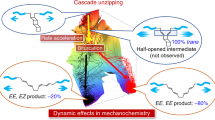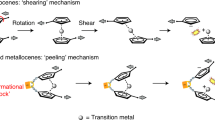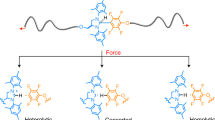Abstract
Forbidden reactions, such as those that violate orbital symmetry effects as captured in the Woodward–Hoffmann rules, remain an ongoing challenge for experimental characterization, because when the competing allowed pathway is available the reactions are intrinsically difficult to trigger. Recent developments in covalent mechanochemistry have opened the door to activating otherwise inaccessible reactions. Here we report single-molecule force spectroscopy studies of three mechanically induced reactions along both their symmetry-allowed and symmetry-forbidden pathways, which enables us to quantify just how ‘forbidden’ each reaction is. To induce reactions on the ~0.1 s timescale of the experiments, the forbidden ring-opening reactions of benzocyclobutene, gem-difluorocyclopropane and gem-dichlorocyclopropane require approximately 130 pN less, 560 pN more and 1,000 pN more force, respectively, than their corresponding allowed analogues. The results provide the first experimental benchmarks for mechanically induced forbidden reactions, and in some cases suggest revisions to prior computational predictions.
This is a preview of subscription content, access via your institution
Access options
Subscribe to this journal
Receive 12 print issues and online access
$259.00 per year
only $21.58 per issue
Buy this article
- Purchase on Springer Link
- Instant access to full article PDF
Prices may be subject to local taxes which are calculated during checkout




Similar content being viewed by others
References
Woodward, R. B. & Hoffmann, R. Conservation of orbital symmetry. Angew. Chem. Int. Ed. Engl. 8, 781–853 (1969).
Houk, K. N., Li, Y. & Evanseck, J. D. Transition structures of hydrocarbon pericyclic reactions. Angew. Chem. Int. Ed. Engl. 31, 682–708 (1992).
Baldwin, J. E., Andrist, A. H. & Pinschmi, R. K. Orbital-symmetry disallowed energetically concerted reactions. Acc. Chem. Res. 5, 402–406 (1972).
Brauman, J. I. & Archie, W. C. Energies of alternate electrocyclic pathways—pyrolysis of cis-3,4-dimethylcyclobutene. J. Am. Chem. Soc. 94, 4262–4265 (1972).
Hickenboth, C. R. et al. Biasing reaction pathways with mechanical force. Nature 446, 423–427 (2007).
Lenhardt, J. M., Black, A. L. & Craig, S. L. gem-dichlorocyclopropanes as abundant and efficient mechanophores in polybutadiene copolymers under mechanical stress. J. Am. Chem. Soc. 131, 10818–10819 (2009).
Lenhardt, J. M. et al. Trapping a diradical transition state by mechanochemical polymer extension. Science 329, 1057–1060 (2010).
Klukovich, H. M. et al. Tension trapping of carbonyl ylides facilitated by a change in polymer backbone. J. Am. Chem. Soc. 134, 9577–9580 (2012).
Ong, M. T., Leiding, J., Tao, H. L., Virshup, A. M. & Martinez, T. J. First principles dynamics and minimum energy pathways for mechanochemical ring opening of cyclobutene. J. Am. Chem. Soc. 131, 6377–6379 (2009).
Ribas-Arino, J., Shiga, M. & Marx, D. Understanding covalent mechanochemistry. Angew. Chem. Int. Ed. 48, 4190–4193 (2009).
Kochhar, G. S., Bailey, A. & Mosey, N. J. Competition between orbitals and stress in mechanochemistry. Angew. Chem. Int. Ed. 49, 7452–7455 (2010).
Wiita, A. P., Ainavarapu, R. K., Huang, H. H. & Fernandez, J. M. Force-dependent chemical kinetics of disulfide bond reduction observed with single-molecule techniques. Proc. Natl Acad. Sci. USA 103, 7222–7227 (2006).
Wu, D., Lenhardt, J. M., Black, A. L., Akhremitchev, B. B. & Craig, S. L. Molecular stress relief through a force-induced irreversible extension in polymer contour length. J. Am. Chem. Soc. 132, 15936–15938 (2010).
Klukovich, H. M., Kouznetsova, T. B., Kean, Z. S., Lenhardt, J. M. & Craig, S. L. A backbone lever-arm effect enhances polymer mechanochemistry. Nature Chem. 5, 110–114 (2013).
Roth, W. R., Rekowski, V., Borner, S. & Quast, M. Forbidden reactions. 2. The disrotatory cyclobutene ring opening. Liebigs Ann. 409–430 (1996).
Getty, S. J., Hrovat, D. A. & Borden, W. T. Ab-initio calculations on the stereomutation of 1,1-difluorocyclopropane—prediction of a substantial preference for coupled disrotation of the methylene groups. J. Am. Chem. Soc. 116, 1521–1527 (1994).
Tian, F., Lewis, S. B., Bartberger, M. D., Dolbier, W. R. & Borden, W. T. Experimental study of the stereomutation of 1,1-difluoro-2-ethyl-3-methylcyclopropane confirms the predicted preference for disrotatory ring opening and closure. J. Am. Chem. Soc. 120, 6187–6188 (1998).
Dopieralski, P., Ribas-Arino, J. & Marx, D. Force-transformed free-energy surfaces and trajectory-shooting simulations reveal the mechano-stereochemistry of cyclopropane ring-opening reactions. Angew. Chem. Int. Ed. 50, 7105–7108 (2011).
Parham, W. E. & Yong, K. S. Steric effects in the solvolysis of cis- and trans-1,1-dichloro-2,3-dipropylcyclopropane. J. Org. Chem. 33, 3947–3948 (1968).
Marszalek, P. E., Oberhauser, A. F., Pang, Y-P. & Fernandez, J. M. Polysaccharide elasticity governed by chair-boat transitions of the glucopyranose ring. Nature 396, 661–664 (1998).
Ribas-Arino, J., Shiga, M. & Marx, D. Unravelling the mechanism of force-induced ring-opening of benzocyclobutenes. Chem. Eur. J. 15, 13331–13335 (2009).
Roth, W. R. et al. Energy profile of ortho-quinodimethane–benzocyclobutene equilibrium. Chem. Ber. 111, 3892–3903 (1978).
Lenhardt, J. M. et al. Reactive cross-talk between adjacent tension-trapped transition states. J. Am. Chem. Soc. 133, 3222–3225 (2011).
Hummer, G. & Szabo, A. Kinetics from nonequilibrium single-molecule pulling experiments. Biophys. J. 85, 5–15 (2003).
Getty, S. J., Hrovat, D. A., Xu, J. D., Barker, S. A. & Borden, W. T. Potential surfaces for cyclopropane stereomutations—what a difference geminal fluorines make. J. Chem. Soc. Faraday Trans. 90, 1689–1701 (1994).
Liang, J. & Fernandez, J. M. Mechanochemistry: one bond at a time. ACS Nano 3, 1628–1645 (2009).
Tian, Y. C., Kucharski, T. J., Yang, Q. Z. & Boulatov, R. Model studies of force-dependent kinetics of multi-barrier reactions. Nature Commun. 4, 2538 (2013).
Yang, Q-Z. et al. A molecular force probe. Nature Nanotech. 4, 302–306 (2009).
Boulatov, R. Reaction dynamics in the formidable gap. Pure Appl. Chem. 83, 25–41 (2011).
Grandbois, M., Beyer, M., Rief, M., Clausen-Schaumann, H. & Gaub, H. E. How strong is a covalent bond? Science 283, 1727–1730 (1999).
Acknowledgements
This material is based on work supported by the US Army Research Laboratory and the US Army Research Office under grant W911NF-12-1-0337. S.L.C. acknowledges partial support from the National Science Foundation Materials Interdisciplinary Research Teams (DMR-1122483). Part of this work was performed under the auspices of the US Department of Energy by the Lawrence Livermore National Laboratory under Contract DE-ACS2-07NA27344. The authors thank B. Akhremitchev for providing the original force-extension modelling code.
Author information
Authors and Affiliations
Contributions
J.W. and S.L.C. conceived and designed the experiments. J.W. and H.M.K. performed the synthesis. T.B.K. collected the AFM data. Z.N. and A.L.R. performed the crystallography. M.T.O. and T.J.M. performed the calculations of the transition states. J.W. and S.L.C. analysed the data and wrote the manuscript.
Corresponding author
Ethics declarations
Competing interests
The authors declare no competing financial interests.
Supplementary information
Supplementary information
Supplementary information (PDF 2995 kb)
Supplementary information
Crystallographic data for compound 4. (CIF 18 kb)
Supplementary information
Crystallographic data for compound 7. (CIF 898 kb)
Rights and permissions
About this article
Cite this article
Wang, J., Kouznetsova, T., Niu, Z. et al. Inducing and quantifying forbidden reactivity with single-molecule polymer mechanochemistry. Nature Chem 7, 323–327 (2015). https://doi.org/10.1038/nchem.2185
Received:
Accepted:
Published:
Issue Date:
DOI: https://doi.org/10.1038/nchem.2185
This article is cited by
-
The many flavours of mechanochemistry and its plausible conceptual underpinnings
Nature Reviews Chemistry (2021)
-
Distal conformational locks on ferrocene mechanophores guide reaction pathways for increased mechanochemical reactivity
Nature Chemistry (2021)
-
Single-molecule observation of mechanical isomerization of spirothiopyran and subsequent Click addition
Nano Research (2021)
-
Three concomitant C–C dissociation pathways during the mechanical activation of an N-heterocyclic carbene precursor
Nature Chemistry (2020)
-
The role of polymer mechanochemistry in responsive materials and additive manufacturing
Nature Reviews Materials (2020)



